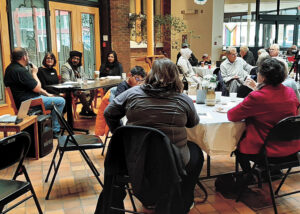The Truth and Reconciliation Commission (TRC) is in the closing stretch of its five-year mandate.
The most important truth being conveyed is the experience of former Indian Residential School (IRS) students. Only they can tell their stories. The TRC appears to have effectively created the venues infused with ceremonial significance for this to happen with respect and the needed personal supports to address the pain that surfaces along the way.
In terms of the truth of what the IRS system was, how it was operated, who was in charge, and why things went so wrong, I am less confident that the TRC will succeed. As a result, the prospects for genuine reconciliation with non-aboriginal Canadians are remote. A modest proposal to enhance the possibility for truth and reconciliation in the future results from the 13 years I spent trying to understand the history and legacy of IRS.
In 1992, I started working for the national office of the United Church of Canada, which included the churches’ response to IRS. From 1998 to 2005, I continued the work as a self-employed litigation researcher for churches and the federal government, which faced tens of thousands of IRS-related lawsuits.
By the early 1990s, the churches historically associated with IRS had apologized for their role and started supporting programs to assist community-level healing processes. I contributed to this work undertaken by the United Church. Sitting in sharing circles with former IRS students provided a window into the childhood agony of being separated from parents and home. Abuses of many kinds were recounted.
The work changed dramatically in 1995, when a former dorm supervisor in an IRS in Alberni, B.C., pleaded guilty in criminal court to sexually abusing boys in his care in the 1960s. Civil lawsuits were filed in 1996, starting with 28 former students.
The United Church entered the formal legal process with lawyers and evidence. I took on the job of finding IRS documentation to assist in the legal defence.
In 1998, I gave a deposition for the United Church at the Blackwater trial before the B.C. Supreme Court, spending five days in total testifying in the pre-trial discovery process and then at the trial in Nanaimo.
My testimony boiled down to two basic points:
- The federal government, not the church, controlled Alberni IRS and employed its staff.
- The role of the church in IRS was to: nominate the principal, but the federal government appointed him; provide chaplains; and liaise with Indian Affairs on IRS matters at the national level.
After a three-year trial, the court assigned 75 percent of the liability to the federal government and 25 percent to the church, and awarded damages to the plaintiffs. In 2003, the decision of the B.C. Court of Appeal was that the federal government was 100 percent liable. Two years later, the Supreme Court of Canada concurred with the earlier trial decision, assigning a 75-25 split in liability.
Having settled the liability split, the Supreme Court decision cleared the way for the federal government to finalize with the church and national aboriginal organizations a comprehensive out-of-court IRS settlement process. Establishment of the TRC was part of the package. In 2008, the federal government finally apologized on behalf of all Canadians in a moving ceremony in the House of Commons.
Obstacles to reconciliation
The first obstacle to reconciliation, from my review of millions of IRS documents in thousands of federal government files, is the popular view that IRS were church institutions, with the federal government merely contracting for a service and providing the money. This is factually incorrect.
I found key documents that convincingly prove the federal government’s controlling role in IRS. Justice Department legal opinions from the 1960s confirmed that IRS staff were federal Crown employees. As a result, liability for staff actions rests fully with the federal government.
The second major obstacle to reconciliation flows from the first. Sadly, public ceremonies organized by the TRC over the past few years have been attended primarily by church people, who shared in the grief of former IRS students. With some exceptions, other Canadians have been largely indifferent because they don’t see it as their fault or problem.
Turning the tables
A modest proposal for a concrete act of reconciliation and atonement for IRS would be the legally enforced removal of the next five generations of mainstream Canadian children from their homes to residential schools in first nation communities. The system would be purposefully underfunded to save taxpayers their hard-earned money.
Teachers would all be status Indians. The language of instruction would be the prevailing indigenous language where the particular residence is located. Children would be allowed to return home periodically, for summers or Christmas holidays. There would be no legal recourse for parents who objected.
After 100 years, we could sit down together and review the impact of this residential schooling on non-aboriginal Canadians.
John Siebert is a member of Stirling Avenue Mennonite Church, Kitchener, Ont.
For more on Mennonites and the Truth and Reconciliation Commission, see:
‘The truth was hard’
Anabaptist church leaders offer statement to residential school survivors
‘A foolish act of love’
‘Four directional thinking’ on indigenous-settler relations
American Mennonites attended past TRC event
One thing lacking (sermon)
Who is blind? (sermon)
Truth and reconciliation is ‘sacred work’
Day schools issue hits home






Leave a Reply
You must be logged in to post a comment.